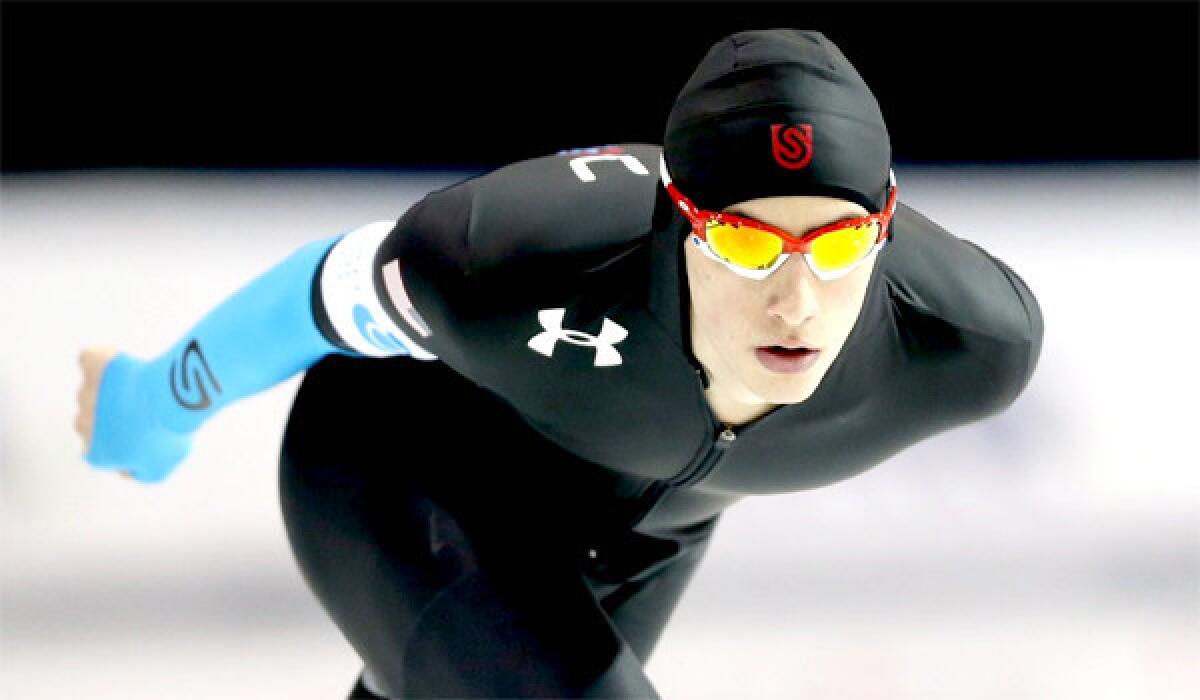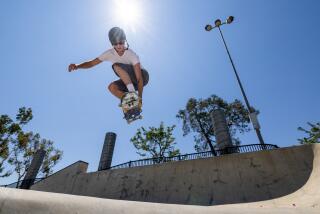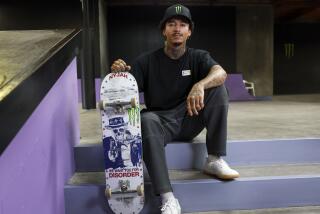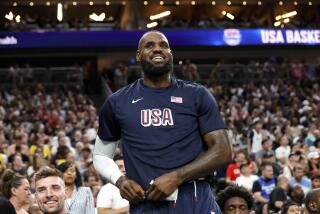Speedskater Emery Lehman took unique route to Sochi Olympics

Emery Lehman’s speedskates are not common at the elite level of his sport. His 18-inch blades are about an inch longer than usual. The company that produces them is different from nearly all used by his teammates. And he wears stock boots 1/10th the cost of custom ones his competitors wear.
“They’re just really comfortable skates for me,” he said, smiling after a recent practice. “I’ve had these for four years, so I have a lot of wear and tear in them.”
Like his footwear, Lehman is anything but orthodox.
Just 17, he will be the youngest U.S. male Olympian in Sochi, Russia. Instead of specializing in one sport, he has starred in three. And unlike many Olympic athletes who leave home to train, the Chicago-area native lives with his parents and will graduate from his local high school.
Lehman earned his spot on the team in December at the Olympic trials after finishing second in the 5,000 meters. But the real fun came five days later when he shocked the crowd at the Utah Olympic Oval and beat Olympic medalist Jonathan Kuck in the 10,000 by a skate’s length. It was only the sixth time Lehman had raced the 10,000.
“That was pretty crazy,” Lehman said. “Every day I’m waking up saying, ‘Oh, wow, I’m going to Sochi.’”
He was 12 and in the sport for just three years when he captured his first national title. Four years later, he won the 5,000 at the senior U.S. championships and followed that up with two medals at the junior world championships. He now owns three of five national junior records.
“He’s amazing right now for 17 years old,” said Olympic gold medalist Dan Jansen, who was 18 at his first Games in 1984. “To me, he’s the future of distance skating in the United States.”
For Lehman, the lure of speedskating is the thrill of pushing the envelope.
“It’s just fun, going around the corners,” he said, “and sometimes you’re not sure if you’re going to fall or not — just from being unstable or not comfortable, going that fast or not having your balance in the right place.”
Still just a kid.
Hockey, not speedskating, was Lehman’s first love on the ice. But if it weren’t for his mother, Marcia, he might not have tried either.
She forced him to try ice skating when he was 3. When he was 9 — already playing hockey for six years — he was at a hockey clinic when Marcia spotted a poster for a speedskating class. She thought his skating could improve for hockey.
“He said, ‘No way,’” she said. “I said, ‘You’re going to try it once, and if you don’t like it, we’ll never do it again.’”
He played a few sports, but hockey and lacrosse — which he started in sixth grade — formed his power trifecta with speedskating. He has been an all-star defenseman in hockey, and this was his first winter in 12 years not playing. In lacrosse, he plays midfield for his high school and until this year played on an elite travel team, Team One.
Lehman started skating with the Franklin Park speedskating club, and by the time he was 12, he’d won short-track and long-track titles at the junior national championships. Two years later, he became the first junior in the world to race a 5,000 in less than 7 minutes.
“At that point, you knew that if he stuck with it and the progression continued, he could become a really elite skater,” said Lehman’s dad, Dave, who works in commercial real estate.
As a high school freshman, Lehman already was concentrating on long-track when he linked up with two-time Olympian Jeff Klaiber. Klaiber said the 6-foot, 172-pound Lehman has a great lactate profile, which is key for endurance athletes; “extremely good tolerance for pain” and incredible feel for the ice.
“He’s a natural athlete,” Klaiber said. “He can jump from sport to sport like nobody’s business and just jump right in and be great.”
In February 2012, Lehman won three titles at the junior championships. Later that year, at the U.S. team trials, he raced a 5,000 in 6 minutes 28.56 seconds, making him the youngest skater to break 6:30, and earned a spot on the World Cup team.
That December, at the national championships in Salt Lake City, he won the 5,000. In February 2013, at the junior world championships, he won the 5,000 and took bronze in the 3,000.
“When he’s on the ice, it’s almost like he’s a man,” his dad said. “It’s all business and focus. It’s like you’re watching a professional.”
Lehman is easy to spot on the ice not only because he wears the same winter hat his mom bought at a meet years ago. He’s also the only one who warms up with a neck warmer draped around his face — during the trials he wore one with the Bears logo — because it keeps the wind out of his mouth.
Lehman’s only routine before training — taking naps — is no superstition. It’s how he finds order through chaos.
He trains two hours away in Milwaukee four days a week, often leaving school about noon to grab lunch at home. If Lehman’s mother can’t drive him, he gets a lift from Steve Penland, his former coach.
One weekday he trains off the ice, while Saturdays are often races. Sunday is his day off.
“He has to have one, right?” Marcia Lehman said.
Lehman gets nervous before races. His biggest challenge is being mentally prepared.
“Being mentally tough is definitely something I’ve been working on, and it has helped a lot,” he said. “What the great skaters do is ... if they get tired, they just push themselves a little bit more, as opposed to some people who start off really well and once they get tired, they kind of give up and they think that all hope is lost.”
At the Olympic trials, a crowd of 3,000 in suburban Salt Lake City and an NBC broadcast made the event the biggest stage of his young career. He tried to block out the atmosphere.
“Thinking, ‘You’re on national television,’ probably would not have helped,” he said, laughing.
The preparation paid off, in part because he was hoping only to qualify for the 5,000.
With three laps to go in the 10,000, Lehman was about four seconds behind Kuck — his training partner and the skater he most admires. Lehman said he noticed Kuck losing steam, and he stayed consistent.
As the final lap began, Lehman pushed ahead. He raised his index finger when he crossed the finish line before the official time was posted.
“It’s pretty crazy,” he said. “Definitely did not expect it.”
Last month, his high school had an assembly wishing him good luck. Then it was off to train on an outdoor track in the mountains of northern Italy in Collabo — where he won his two junior world championship medals — before arriving in Sochi, which has a lower altitude similar to that of Milwaukee.
Should he defy expectations and reach the medal podium, he would become the youngest male speedskater to do so since Alv Gjestvang of Norway in 1956.
He and Klaiber are just hoping for a top-12 finish. This time, the experience is what matters. He is ranked 26th in the world in the 5,000.
Lehman will rely on the skates that helped get him to Sochi. They’re no longer in production, but his mother found two pairs in Canada. Lehman also uses Viking blades instead of Maple, the choice of most skaters on the U.S. team, including Shani Davis.
Davis once suggested to Lehman not to change anything with his skates if they felt fine. Now Lehman applies that advice throughout his training.
“I’ve debated if this is really right for me — and then looking back how much success it has brought me — and it has helped,” he said. “So why stop now?”
Twitter: @jaredshopkins
#!/jaredshopkins”>@jaredshopkins
More to Read
Go beyond the scoreboard
Get the latest on L.A.'s teams in the daily Sports Report newsletter.
You may occasionally receive promotional content from the Los Angeles Times.










